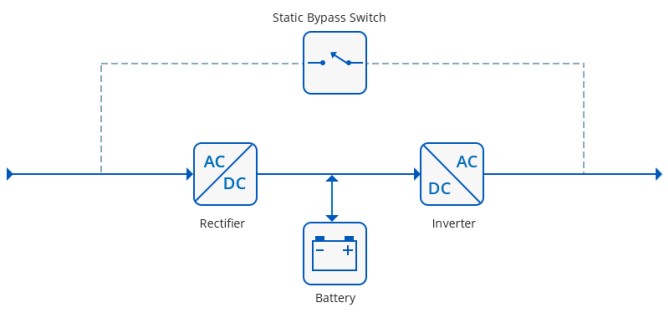LINE-INTERACTIVE UPS
LINE-INTERACTIVE UPS A line-interactive UPS maintains the inverter in line and redirects the battery’s DC current path from the normal charging mode to supplying current when power is lost. In this design, the battery-to-AC power inverter is always connected to the output of the UPS. When the input AC power is normal, the inverter of the UPS is in reverse operation and provides battery charging. Once the input power fails, the transfer switch will open and the power will flow from the battery to the UPS output. This design offers additional filtering and yields reduced switching transients since the inverter is always on and connected to the output. Line interactive UPS systems are a cheaper option than online double conversion technology and will protect a critical load from power failures, power sags, power surges, under-voltage and over-voltage. Unlike the online double conversion topology, it will not protect against electrical line noise, frequency variation, switching transient and harmonic distortion

ONLINE UPS
An online UPS uses a “double conversion” method of accepting AC input, rectifying to DC for passing through the rechargeable battery then inverting back to 120 V/230 V AC for powering the protected equipment.
In an online UPS, the input AC is charging the backup battery source which provides power to the output inverter, so the failure of the input AC won’t cause activation of the transfer switch. That is to say, if a power loss occurs, the rectifier will simply drop out of the circuit and the batteries will keep the power steady and unchanged. No transfer time during the failure. When power is restored, the rectifier will resume carrying most of the load and begin charging the batteries, though the charging current may be limited to prevent the high-power rectifier from overheating the batteries and boiling off the electrolyte.
Although the initial cost of an online UPS system is greater than a line interactive system, the total cost of ownership (TCO) is generally lower as the batteries tend to last longer.
- Offers the highest level of critical load protection as the load is supplied with closely regulated power at all times
- Has a load break of less than 5ms when transferring between inverter and bypass
- Is totally transparent to the load in the case of a mains failure
- Is the most expensive capital cost of UPS systems
- Has a higher running cost than other types of system, as the rectifier and inverter are permanently on load.

FUNCTIONS
Surge/Noise Protection Both line-interactive and online UPS systems possess surge suppression and line noise filtering functions to shield the equipment from damage caused by lightning, surges, and electromagnetic (EMI/RFI) line noise. Particularly, the online UPS system offers superior protection on account of the double-conversion operation that isolates equipment from problems on the AC line.
Transfer Time to Battery During an outage, a break in power to a load of typically 2 to 10 milliseconds is inevitable in offline/standby UPS systems, while line-interactive UPS systems typically transfer from line power to battery-derived power within 2 to 4 milliseconds, faster enough to keep all but a small percentage of the most power-sensitive equipment operating without interruption. Surprisingly, the online UPS system does not have a transfer time, because the inverter is already supplying the connected equipment load when an outage occurs.
Voltage Regulation As is known, the voltage regulation is crucial, especially for low voltage conditions. Line-interactive UPS systems use automatic voltage regulation (AVR) to correct abnormal voltages without switching to battery. When voltage crosses a preset low or high threshold value, this type of UPS will detect and use transformers to boost or lower the voltage by a set amount to return it to the acceptable range. Online UPS systems adopt a more precise method of voltage regulation: continuous “double-conversion” operation, isolating connected equipment from problems on the AC line, including blackouts, brownouts, overvoltages, harmonic distortion, electrical impulses, and frequency variations. When not operating from the battery, line-interactive UPS systems typically regulate output within ±8-15% of the nominal voltage (e.g. 120, 208, 230, or 240 volts), whereas online UPS systems typically regulate voltage within ±2-3%. In fact, there are some common power issues that may occur in daily operations. The table below will present whether the above-mentioned UPS system will protect against the anomalies:
| UPS | Line-interactive | Online |
| Power Failure | Yes | Yes |
| Power Sag | Yes | Yes |
| Power Surge | Yes | Yes |
| Under-Voltage | Yes | Yes |
| Over-Voltage | Yes | Yes |
| Electrical Line Noise | Yes | |
| Frequency Variation | Yes | |
| Switching Transient | Yes | |
| Harmonic Distortion | Yes |
Summary
The choice between an online, offline or line interactive UPS depends on the business needs and requirements. Most users with highly critical loads will inevitably choose online UPS topology because of its ability to protect sensitive equipment and data from mains problems at all times. For many, this security far outweighs any extra cost consideration – especially as modern UPS hardware has become highly efficient in operation, significantly reducing excess operating costs.
